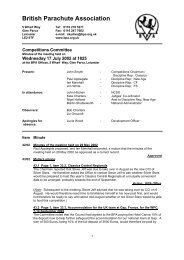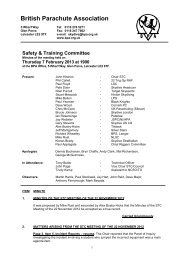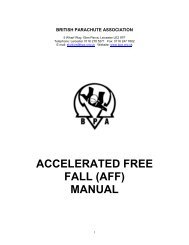Formation Skydiving Progression Manual - British Parachute ...
Formation Skydiving Progression Manual - British Parachute ...
Formation Skydiving Progression Manual - British Parachute ...
You also want an ePaper? Increase the reach of your titles
YUMPU automatically turns print PDFs into web optimized ePapers that Google loves.
Appendix F: FS Skills Theory - Dive to and<br />
Approach a Target/Swoop to Pin<br />
To dive and approach a target or to “swoop to pin” would normally be performed if you were part<br />
of a large formation load and were one of the last to leave the aircraft. Being the last to leave the<br />
aircraft creates a few problems to the skydiver and so requires lots of practice to get it right which<br />
is why it is usually left to the most skilful or experienced skydivers on the load.<br />
If you are inexperienced in big ways then it is advisable to be as close to the door as possible on<br />
exit. However if you want to challenge yourself, and have more fun, then try getting further back<br />
in the line up.<br />
The first challenge you have when leaving the aircraft, some time after the formation is the<br />
distance between you and whoever has already left. The distance is both vertical and horizontal<br />
and you should close the vertical distance as much possible before closing the horizontal<br />
although the last few hundred feet can be a combination of the two.<br />
The second challenge when swooping down to a formation is eye contact. We rely heavily on<br />
what we see in FS as a visual reference to where we are in relation to others but when swooping<br />
we may lose sight of who is below us in order to maintain a vertical dive approach. Because we<br />
can’t rely on visual feedback we need to rely on timing and anticipation, which obviously improves<br />
with practice. However, if you do lose sight of anyone below, it is better to stop and locate the<br />
other skydiver(s) and then continue. Also, a top tip is that it is ALWAYS better to recover out of a<br />
swoop too early and be high on the formation than to be too late and go low on a formation.<br />
It is vital to be proficient at this skill for your safety and enjoyment in formation skydiving. Too fast<br />
approaching the formation and you are putting yourself and others on your formation at risk of<br />
collision and possible injury, too slow and you may not make it to the formation at all.<br />
Reducing the vertical distance is the first priority and to do this we have to use the vertical dive or<br />
the no lift dive position as shown in F.15.<br />
The vertical dive position is also known as a no lift dive position<br />
because it creates minimum lift as it has a very low angle of attack in<br />
relation to the relative air. Obviously, this is the quickest way to lose<br />
vertical distance due to minimum air resistance. To transition into this<br />
position you start from a dive exit then swoop back the arms and<br />
extend the legs as if you were tracking. Try to maintain visual contact<br />
with your formation at all times – if possible.<br />
The “Stadium” Approach. How much time you spend in the vertical<br />
dive position whilst reducing vertical distance depends on how long<br />
you wait before leaving the aircraft after the target but remember it is<br />
better to be too early than too late. By maintaining eye contact with<br />
your coach or formation as you reduce the vertical separation your<br />
head will naturally lift, which assists in your transition from the vertical<br />
dive to a “flatter” position. As your angle of attack changes it produces<br />
more air pressure on the underside of your body, slowing your rate of<br />
descent.<br />
Be aware that you are now travelling at a much higher speed than you<br />
have experienced before. To reduce speed quickly from this position<br />
we can use the body flare. Judging when to flare requires anticipation<br />
and its best to err on the side of caution and aim to be early.<br />
Fig. F.15<br />
24
















